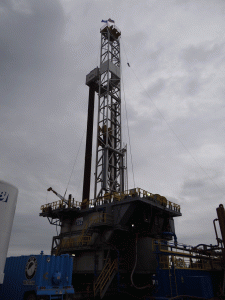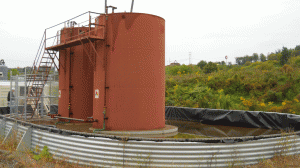Fracking Waste Could Increase Carcinogens in NC Drinking Water

Chemicals in water from deep underground in hydraulic fracturing wells have caused problems as they get to water treatment plants in other states. It’s a potential problem to consider as North Carolina moves closer to allowing fracking.
It began as a routine test of drinking-water quality.
In 2010, the Pittsburgh Water and Sewer Authority was taking samples from its distribution system. When the lab results came back, PWSA’s staff was surprised.
“All of a sudden we saw very high – very high – [trihalomethane] levels in the distribution system,” said Stanley States, PWSA’s former director of water quality and production.
Trihalomethanes are byproducts of the process used to disinfect water. Research has linked the chemicals to several health problems, including bladder cancer. The federal government sets limits on their concentration in drinking water.
The concentration of trihalomethanes was unusually high in PWSA’s drinking water. So the utility’s staff began to look for the problem’s source. PWSA teamed up with engineering researchers at the University of Pittsburgh, and throughout 2011 and 2012 the group took monthly water samples from along the Allegheny River, the source of Pittsburgh’s drinking water.
Eventually, the team identified a culprit: industrial wastewater plants that were treating water from hydraulically fractured gas wells.
These plants were ill-equipped to treat the wastewater, the team found, and were releasing drilling byproducts into the Allegheny. Those byproducts were then flowing downstream and causing trihalomethanes to form in Pittsburgh’s drinking water.
Pennsylvania’s experience points to the numerous, unforeseeable challenges associated with processing the waste from hydraulic fracturing. These are challenges that North Carolina will face, as it prepares for its own industry of natural-gas drilling.
After Pennsylvania’s environment agency learned about this problem, it urged drillers to stop taking their water to the wastewater plants, according to Victoria Binetti, the U.S. Environmental Protection Agency’s associate director of its water-protection division, in Region 3 of the agency.
The request was not legally binding, but drillers appeared to change their practices.
“To their credit, most of them complied,” she said.
The story in Pennsylvania raises a question: whether, as in the past, North Carolina’s regulators will react after the fact to control trihalomethanes caused by an energy industry, or whether regulators will set rules to prevent the chemicals from forming.
The brine trapped in shale
Water plays a crucial role in hydraulic fracturing, as the name suggests. Hydraulic fracturing, or fracking, is a process in which water, sand and chemicals are pumped into wells at high pressures. This causes fissures in deep shale deposits, releasing natural gas and oil from the dense rock.
But shale contains more than just gas and oil. It also stores water. Fracking releases this water too, which drillers call “produced water.” Produced water flows to the surface after “flowback,” portions of the water originally pumped into the well.
Like flowback, produced water must eventually be dealt with.
In Pennsylvania, drillers often sent their wastewater to industrial treatment plants and municipal wastewater plants – the kind that treat, say, apartment buildings’ sewage. But neither type of plant was designed to treat fracking waste, according to PWSA’s States. Both types of plants treated the water as best they could, then released it into state rivers, as permitted by federal and state laws.
Whenever – and if ever – drilling begins in North Carolina, energy developers will be much more constrained.
The N.C. Mining and Energy Commission is developing rules for fracking, including rules that govern fracking’s wastewater. Commission members have learned from states like Pennsylvania. Under rules the commission has tentatively approved, drillers will not be able to send their waste to municipal plants.
“The mistake that they made in Pennsylvania was, these things were sent to [municipal plants], as if it was just normal waste, and it’s not,” said Vikram Rao, a member of the M.E.C. and chairman of the committee that developed the wastewater rules.
But drillers will be allowed to send their wastewater to commercial plants, he said. These plants must be designed specifically to treat fracking wastewater.
But no such plants currently exist in North Carolina.
Drillers will also be allowed to haul their waste out of state and to use onsite technology to treat their water.
Yet even with onsite treatment or a specially designed wastewater plant, concentrations of one chemical class may still find their way into state waters.
Those chemicals are bromides, the catalysts for trihalomethanes in Pittsburgh’s drinking water, and, according to States, a particularly difficult chemical to filter out of fracking water.
“To remove dissolved solids like bromides is very difficult,” he said. “Typically, you have to use ion exchange and reverse osmosis. Very expensive.”
How fracking water catalyzes trihalomethanes
Produced water can be highly saline, and can contain a number of minerals, owing to its former presence within shale.
“If it’s highly saline, it’s got a lot of chloride and a lot of bromide,” said Philip Singer, a professor emeritus of environmental engineering at the University of North Carolina-Chapel Hill.
If wastewater-treatment systems fail to remove bromides before re-releasing the water, the chemicals simply flow downstream. There, drinking water-plant intakes slurp up the chemical-laden water from rivers, as happened at the water-treatment plant that serves Eden.
Drinking-water plant operators then often treat the river water with chlorine; this kills harmful bacteria.
But chlorine and bromides don’t play well together.
When bromides mix with chlorine and decaying matter – tree leaves, river grasses – drinking-water plants can begin to form high levels of trihalomethanes.
According to Singer, one type of trihalomethane, chloroform, forms without the presence of bromides.
But, he said, the brominated trihalomethanes – the ones that require bromides – have more harmful health effects.
Health researchers have linked bladder cancer to long-term exposure to trihalomethanes, and the EPA warns that trihalomethane exposure over the long term can harm kidneys, livers and central nervous systems.
According to the American Water Works Association, one brominated trihalomethane, dibromochloromethane, is about 17 times more carcinogenic than chloroform.
A lack of data
It’s hard to say whether hydraulic fracturing will increase bromide concentrations in North Carolina’s rivers.
For one, North Carolina’s shale is different from Pennsylvania’s, according to the MEC’s Rao.
North Carolina’s shale formed “in inland water, not in ocean beds,” like Pennsylvania’s Marcellus Shale formation, he said.
Bromide occurs naturally in seawater. And without a marine origin, North Carolina’s shale water might have a lower level of bromides, according to Detlef Knappe, a professor of environmental engineering at North Carolina State University.
Yet, without actual measurements, assessing bromide levels in shale water is difficult, he said.
The N.C. Department of Environment and Natural Resources does have some data [see documents below] on the state’s shale water, from a test well drilled in 1998.
State geologist Kenneth Taylor said that the water in this sample showed a low level of salinity.
But a low level of salinity does not necessarily point to low levels of bromides, according to Knappe.
As a study by DENR said, “It may not be possible to fully characterize flowback waters from shale gas operations in North Carolina until there is actual wastewater from a North Carolina hydraulic fracturing operation.”
Knappe acknowledges that fracking wastewater in North Carolina could cause problems with trihalomethanes. But, he said, there’s a broader issue at hand.
“If indeed discharge to sewers and eventually surface waters is allowed, then the question of what chemicals are being used altogether in this process is something that needs a lot more scrutiny,” he said.
Knappe noted that drillers will be able to keep secret some of the chemicals they use to fracture wells.
“What is it that could potentially end up in our drinking-water sources?” he asked. “And is it permitted?”
These documents show the the constituents of deep, geologic water from two test wells that were drilled in North Carolina in 1998. This water is known as “produced water,” the unadulterated ground water that contains chemicals similar to those that would be found in a fracked well.
According to by Kenneth Taylor, North Carolina’s State Geologist, employed by DENR, this is some of the only data available on produced water in North Carolina shale formations. However, the water’s bromide levels were not measured.
During the fracking process, between three and five million gallons of water are injected underground. 10-35 percent of that wastewater comes back to the surface; that water is called “flowback,” and can commingle with the produced water. The produced water, a much smaller volume of wastewater, returns to the surface continuously, as long as the well remains active.
This sort of brine water caused problems in PA, because it can have high levels of bromides in it. Wastewater plants that treated the produced water did not effectively remove the bromides before re-releasing the water into rivers. That bromide-laced water then mixed with rivers, and found its way into drinking-water plants downstream, where it catalyzed the formation of trihalomethanes.
This is the only test-well data that DENR has provided to NCHN.
Source(s):
northcarolinahealthnews.org
http://www.healthfreedoms.org/fracking-waste-could-increase-carcinogens-in-nc-drinking-water/


